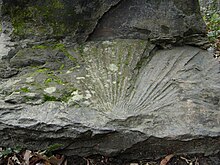Chuckanut Formation
| Chuckanut Formation Stratigraphic range: Early to Late Eocene |
|
|---|---|

Sabalites campbelli frond from the Chuckanut Formation
|
|
| Type | Geological formation |
| Overlies | Nanaimo Group sediments |
| Thickness | up to 6,000 metres (19,690 ft) |
| Lithology | |
| Primary | Fluvial |
| Location | |
| Region | Northwest Washington |
| Country | United States |
| Type section | |
| Named for | Chuckanut Mountains |
The Chuckanut Formation in northwestern Washington (named after the Chuckanut Mountains, near Bellingham), its extension in southwestern British Columbia (the Huntingdon Formation), and various related formations in central Washington (including the Swauk, Roslyn, Manastash, and Chumstick) are fluvial sedimentary formations of Eocene age, deposited from about 54 (millions of years ago) to around 42 to 34 Ma. The nature of the deposits and included plant fossils indicate a low-lying coastal plain with a subtropical climate; the nature of the sediments indicates metamorphic sources in northeastern Washington.
The original Chuckanut/Huntingdon/Swauk formation appears to have been deposited as a single unit in a large basin, and subsequently separated by faulting. The original extent of the formation is unknown, parts having been uplifted and eroded away, and the current extents largely covered by volcanic and glacial deposits. Early work suggested that the marine Nanaimo Group on Vancouver Island was correlated with the Chuckanut, but the Nanaimo Group is now known to be earlier (Upper Cretaceous). The principal outcrops of the Chuckanut Formation (marked CK on the map) are in the vicinity of Bellingham, with other outcrops as far south as the Darrington—Devils Mountain Fault Zone. The Swauk, Roslyn, Chumstick, and Manastash Formations (SW and MA) are on the east side of the Cascade Range and south of Mount Stuart (in the vicinity of Roslyn, Washington); the offset between these and the Chuckanut/Huntingdon is evidence of large-scale (about 110 km) strike-slip motion on the Straight Creek Fault, starting at 48 Ma. Other related formations (such as the Puget Group and Raging River Formation) occur east and south of Seattle. Other sedimentary formations of similar age and environment occur throughout southwestern Washington and western Oregon. Various sedimentary formations underlying Puget Sound and the eastern Olympic Peninsula (such as the Crescent Formation) are of similar age, but petrographically distinct, and appear to have different sources.
...
Wikipedia
